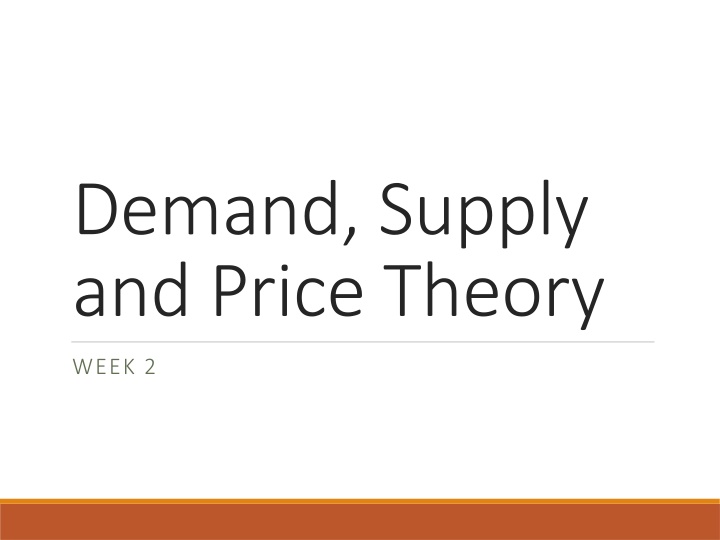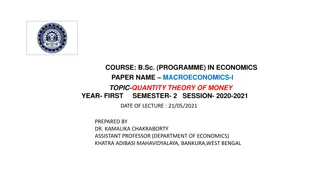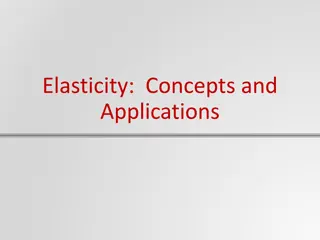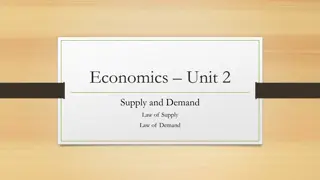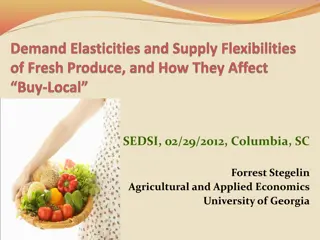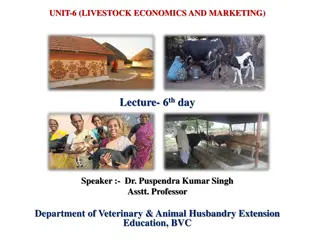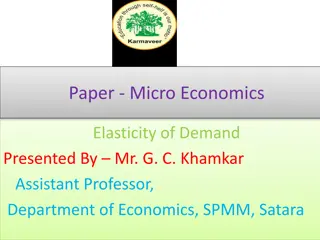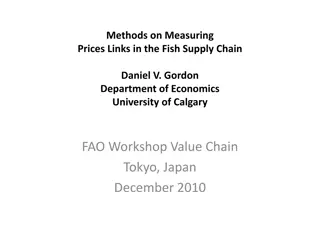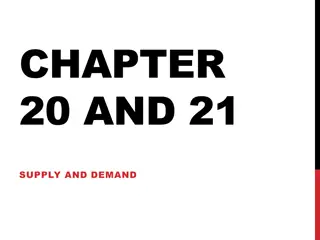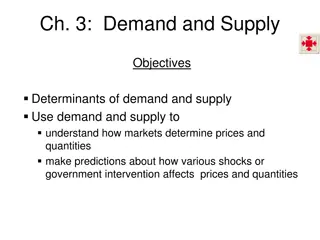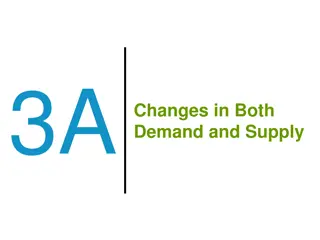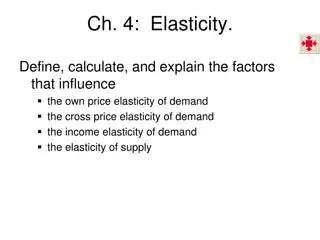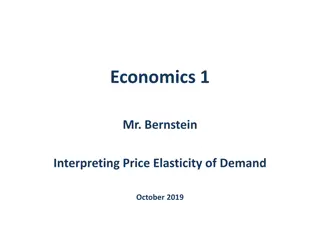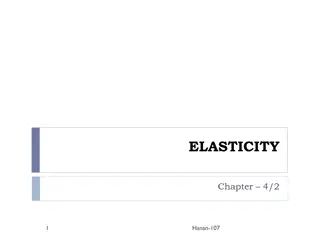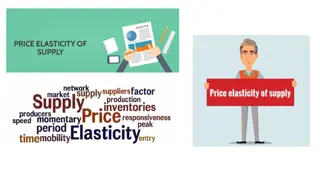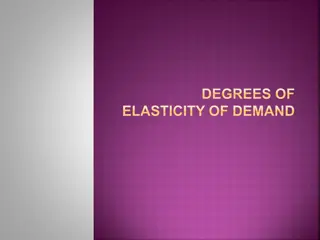Demand, Supply and Price Theory
Delve into the fundamental concepts of economics such as opportunity cost, incentives, trade among countries, productivity, and the relationship between marginal benefit and marginal cost. Explore the application of the scientific method in economics, three economic models, and the workings of market equilibrium, supply, and demand. Gain insights into the circular flow diagram, production possibilities frontier, and the impact of market forces on prices and quantities in various scenarios.
Download Presentation

Please find below an Image/Link to download the presentation.
The content on the website is provided AS IS for your information and personal use only. It may not be sold, licensed, or shared on other websites without obtaining consent from the author.If you encounter any issues during the download, it is possible that the publisher has removed the file from their server.
You are allowed to download the files provided on this website for personal or commercial use, subject to the condition that they are used lawfully. All files are the property of their respective owners.
The content on the website is provided AS IS for your information and personal use only. It may not be sold, licensed, or shared on other websites without obtaining consent from the author.
E N D
Presentation Transcript
Demand, Supply and Price Theory WEEK 2
Recap What is opportunity Cost? Why are incentives important to policy makers? Why isn t trade amongst countries a game with winners and losers? Why is productivity important? What is the relationship between Marginal Benefit and Marginal Cost
The Scientific Method Economics is a Science Economists devise theories, collect data and analyze it Scientific economists make positive statements Develop a model based on simplified assumptions Collect data and test models Identify the problem Everything must be taken into account. If the fact will not fit the theory---let the theory go. Agatha Christie In questions of science, the authority of a thousand is not worth the humble reasoning of a single individual. Galileo Galilei
Three Economic Models The Circular Flow Diagram The production possibilities frontier Market equilibrium
The Circular flow diagram A visual model of the economy that shows how money flows through markets amongst households and firms
Production Possibilities Frontier A graph that shows the combinations of output that the economy can possibly produce given the available factors of production and the available production technology. Example Economy can produce 300 shirts or 100 cakes Producing at the PPF causes the market to be efficient It is easy to see trade offs and opportunity costs Opportunity Cost = the slope of the PPF Line Slope = Change in Y/ Change in X 300-0/100/0 = 3
Markets and Competition What happens To the price of petrol when war breaks out in Iran To the price of mangoes when farmers have an abundant year To the number of tourists when the tsunami hit Sri-Lanka All of the above show the workings of Supply and Demand Supply and Demand are the forces that make market economies work. They determine the following Quantity of Goods produced Price of which goods are sold Markets do very weird things because it reacts to how people behave, and sometimes people are a little screwy. Alan Greenspan
What is a Market? A group of buyers and sellers of a particular good or service. Characteristics of markets Organized markets Less Organized markets. A competitive market is a market which has many buyers and sellers so that each has a negligible impact on price. For today s class we will assume that markets are perfectly competitive. The goods offered for sale are exactly the same so that no single buyer or seller has influence over price.
Demand Quantity Demanded the amount of a good that buyers are willing and are able to pay. Law of Demand The claim that other things equal the quantity Demanded of a good falls when the price of The good increases. Market Demand the sum of all individual demand for a particular good or service Teach a parrot the terms 'supply and demand' and you've got an economist. Thomas Carlyle
Demand Price Quantity Demanded Shifts in the demand curve Demand curves can shift To the RIGHT (A) To the LEFT (B) 0 6 50 5 100 4 Shifts to the right means demand has increased Shift to the left means demand has decreased 150 3 200 2 250 1 300 0
Variables that cause Demand Curves to shift Income Prices of Related goods Tastes Expectations Number of Buyers
Income Normal goods A good for which other things equal an increase in income leads to an increase in demand Inferior Good A good for which other things equal an increase in income leads to a decrease in demand.
Price of Related Goods Substitutes Two goods for which an increase in price of one leads to an increase in demand for the price of the other Complements Two goods for which an increase in the price of one leads to a decrease in demand for the other.
Supply Quantity Supplied The amount of a good that sellers are willing and able to sell. Law of Supply The claim that other things equal the quantity Supplied of a good increase when the price of The good increases.
Supply Price of cone Quantity Supplied 0 0 Shifts in the Supply Curve 50 0 100 1 Shifts to the right increase supply Shifts to the left decrease supply 150 2 200 3 250 4 300 5
Variables that cause the supply curve to shift Input Prices Costs of inputs. If they increase production decreases, if they decrease production will increase Technology Machinery increases productivity Expectation Number of Sellers
Market Equilibrium Equilibrium A situation which the market price has reached the level at which quantity supplied equals the quantity demanded. Equilibrium price the price that balances Qd and Qs Equilibrium quantity the quantity that balances Pd and Ps Law of Supply and Demand The claim that the price of any good adjusts to bring the Qd and the Qs for the good into balance.
Surplus and Shortage Surplus A situation where Qs is greater than Qd Shortage A situation where Qd is greater than Qs No change in Supply An increase in supply Decrease in supply No change in demand P.Q No change P down Q up P up Q down Increase in Demand P up Q up P ambiguous Q up P is up Q ambiguous Decrease in demand P down Q down P down Q ambiguous P ambiguous Q down
Elasticity of Supply and Demand Price Elasticity of Demand We use absolute numbers even though Qd is negatively related to its price. |Ped|= Q/ P = 20/10 = 2
Different Types of Demand Perfectly Inelastic Demand Inelastic Demand Unitary Elastic Demand Elastic Demand Perfectly Elastic Demand
Determinants of Price Elasticity Sustainability Nature of the Product Proportion of Income Definition of Market The Possibility of new purchases Time Horizons Addiction Complementary goods Price expectations
Income Elasticity of Demand A measure of how much the quantity demanded for a good responds to a change in consumers income.
(Ey) Negative elasticity Ey>0 D decreases as I increases Zero Income Elasticity Ey=0 D does not change as I rises of falls Income Inelastic Demand 0<Ey<1 D rises at a smaller proportion than I Unit Income Elasticity Ey=1 D rises exactly the same proportion as I Income elastic demand 1<Ey< - D rises at a greater proportion than income
The Cross Price Elasticity of Demand The measure of how much the quantity demanded of one good responds to a change in the price of another good.
Price Elasticity of Supply Es = Q/Q = Q x P P/P P Q
Determinants of Elasticity of Supply Time Excess Supply or Unsold Stock Factor Mobility Natural Constraints Risk Taking
